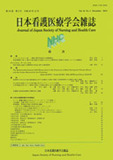Japanese
English
- 有料閲覧
- Abstract 文献概要
- 参考文献 Reference
抄録
目的:排泄障害のある在宅要介護高齢者の排泄状況と訪問看護師が実施している排泄に関する看護介入行動の実態、自然排泄移行の可能性について調査をする。
方法:対象は訪問看護師が選定した在宅要介護高齢者とし、訪問看護師に自記式質問紙調査を行った。分析対象は191人とした。
結果:在宅要介護高齢者は尿意なし70.7%、便意なし59.7%、尿失禁・便秘73.3%、便失禁34.6%、おむつ使用86.4%、摘便実施71.2%であった。介護者は配偶者45.5%で、排泄援助の困難は子よりも有意に高かった。排尿の看護介入行動は陰部洗浄93.7%、排便は腸音モニター94.2%が最多であった。訪問看護師が自然排泄移行可能と判断したのは、排便59.7%、排尿29.3%、排尿・排便共26.7%であり、尿意・便意がある、日常生活自立度が高い、トイレ使用が有意に多かった。
結論:排泄障害のある在宅要介護高齢者の約3割については、尿意・便意があり、日常生活自立度が高く、トイレ使用の場合に自然排泄への移行が可能である。特に排便は排尿よりその可能性が高い。
Abstract
Purpose: The aim of this study was to investigate the elimination situation of elderly patients who require care at home with elimination disorders, the reality of nursing intervention behaviors and the possibility of a transition to spontaneous elimination.
Methods: The subjects were elderly patient requiring care at home who was selected to the visiting nurse. The visiting nurses respond to a self-administered questionnaire that analyzed 191 items.
Results: The elderly with elimination disorders included 70.7% with no desire to urinate, 59.7% with no desire to defecate, 73.3% with urinary incontinence and constipation, 34.6% with fecal incontinence, 80.6% using diapers and disimpaction was applied for 71.2%. The caregivers were the spouse in 45.5% of cases. Spouses felt more difficulty in performing various types of intervention for such patients related to urination and defecation than did children. Of the nursing interventions related to urination, perineal care was carried out most often, in 93.7% of cases. Defecation was monitor the bowel sounds in 94.2% of cases. The visiting nurse determined that there was a possibility of a transition to spontaneous defecation for 59.7% of cases, spontaneous urination for 29.4% and both urination and defecation for 26.7%. The elderly patients who were determined by visiting nurses possible to spontaneously eliminate demonstrated the following characteristics: they recognized the need to urinate and defecate, they had a high degree of independent living, they were able to use a toilet.
Conclusion: Our findings suggest that approximately 30% of elderly patients requiring care at home with elimination disorders can achieve spontaneous elimination if they recognize the desire to urinate and defecate, have a high degree of independent living and can use a toilet. In addition, possibility of transitioning to spontaneous defecations is higher than the possibility of transitioning to spontaneous urination.
Copyright © 2014, Japan Society of Nursing and Health Care All rights reserved.


